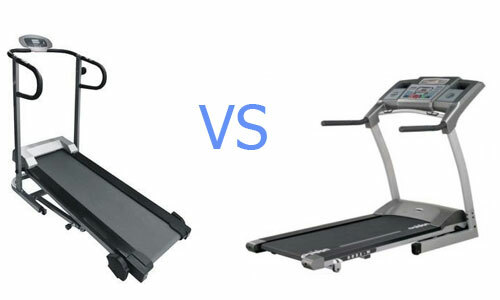To understand which treadmill is better: mechanical or electrical, consider the merits and demerits of both simulators, and based on this information we will decide which one and for whom it will be better.

What is the mechanical and electrical path and how do they differ?
- A mechanical treadmill is a simple design that does not have a special motor - the movement of the belt( it mimics running) is created by the treadmill itself, by repelling the canvas with the feet.
- Electric treadmill - in this simulator the canvas starts to move thanks to a special electric motor. The athlete does not need to make efforts to ensure that the tape creates the illusion of running, the motor will put everything into action independently.
Let's see what each model "knows" and how it can be useful.
| parameters | Schematic | Mechanical |
|---|---|---|
| distance counter | is | is |
| counter | speed is | is |
| pulse sensor | is | is |
| counter burning | calories have | is |
| Tilt | angle is( to 22 degrees) | is( not in all models) |
| Availability of special training programs | is | no |
As you can see, the electric track will be able to set such a parameter as "running on hilly terrain" and other trainingpaid-in program. A mechanical model of this function is not equipped - the intensity of the run will need to be set independently.
Also, some models of mechanical tracks can be equipped with an angle adjustment - usually one or two options, while an electric simulator can have more than five options.
Advantages and disadvantages of the
mechanical track The main advantage of the mechanics is simplicity, which means the following:
- This model has an affordable price
- The track dimensions allow it to be "squeezed" even into a small room
- The simulator does not consume electricity
- The training will be more natural,that the intensity of the run is set by the athlete himself
There are some disadvantages for this type of simulator:
- It is necessary to exert more effort for running
- Due to the independent movementtracks, the load on the spine and joints increases
- The intensity of training will depend only on the athlete himself - to set a special program or load level will not work.
It is important to remember that mechanical models are best used for those who do not have problems with the spine, joints and musculoskeletal system,motor apparatus.
Advantages and disadvantages of
electric tracks Compared to mechanical tracks, such simulators have several advantages:
- Due to the fact that the tape moves thanks to the motor, the "smoothness" of the
- movement is created No additional stress on the spine and joints of the feet
- Special programs will allow faster and more efficientachieve the stated goal
The disadvantages of the models are directly related to the advantages of the simulator:
- The price of this unit is not available to every
- If the track is equipped with modern sensorskami and devices, you need to be prepared for their failure or breakdown and, as a consequence, expensive repairs to the
- . The electric model takes up a lot of space.
. It is also worth remembering that these simulators have "self-moving" parts and children should not be allowed to access this path.
If you just want to keep yourself in shape and not spent on a "super" model with all sorts of programs and sensors - choose a mechanical simulator. If you pursue a complex, specific goal and want to achieve it quickly and effectively - you need an electric simulator. With it, you can lose weight thanks to a special built-in program or increase stamina.


